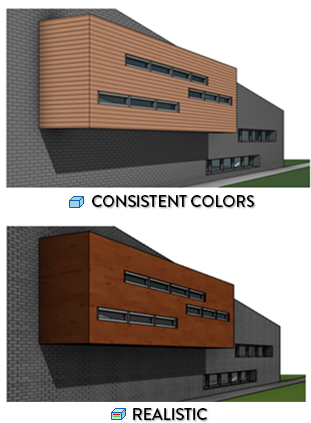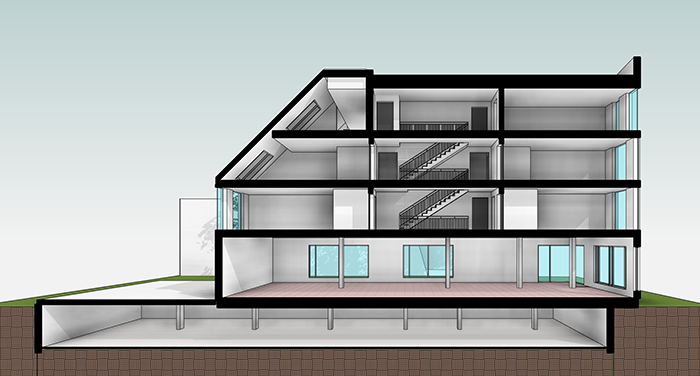8 Tips to Create Beautiful Drawings in Revit
Most architects think that Revit is a terrible presentation tool. They are wrong. And this guide is going to prove it. You dont need sketchup or Photoshop to create interesting conceptual documents.
If you like creating beautiful views, make sure to check out our brand new mysterious, sensual learning package called DESIGN.
In this post, we are going to use the project provided by a Revit Pure reader: Wolfgang Sirtl. The name of the project is: Beckerstrae. It is a 17 apartments building in Ingolstadt, south Germany. Check out this firm website over here: http://www.qsp-architekten.de/
Enough babbling! Lets get started.
1. Adjust Line Weight
A common criticism of Revit is the difficulty to adjust the line weight of elements, especially in elevations and 3D views. In the plan view below, you can see that the line thickness hierarchy is not great the drawing appears flat. The cut walls line thickness is set to 4, meaning it will print at .35mm. Thats pretty thin.

image Revit Pure
Lets go to the Line Weights menu. Go to the Additional Settings dropdown menu in the Manage tab. Select the Line Weights tool. Adjust the number 4 thickness for the correct scale. In the example below, we boost the thickness to 0.5mm. The drawing looks much better!

image Revit Pure
The Line Weights menu is not the only way to affect the thickness. The Linework tool (shortcut: LW) allows you to replace the style of a single line. In the example below, we override a 3D edge to a purple dashed line. Drag the blue dot to adjust the line override boundary.

image Revit Pure
2. Understand Which Visual Style to Use
Revit offers 6 different visual styles. Think carefully about which one to use. For conceptual views, Consistent Colors is often a great choice. Hidden Lines might also be interesting. When you are ready for images that are more realistic, the Realistic style and rendering.

image Revit Pure
A confusing feature of Revit is the difference between the Graphics and Appearance properties of a material. The settings in Graphics will be used in Wireframe, Hidden Lines, Shaded and Consistent Colors styles. The appearance settings, where you can set image textures, are used for Realistic, Raytrace and renderings.
In the image below, we adjust a brick material. In the Graphics tab, we set a line pattern and a color to be used in shaded/consistent colors visual style. In the appearance tab, we set an actual brick texture image.

image Revit Pure

image Revit Pure
As you can see below, Consistent Colors will display materials using line pattern, while Realistic will display the material using image textures.

image Revit Pure
3. Create a Pouche Cut Style
For presentation documents, you probably dont want to see a bunch of wall and floors layers. For example, this is what a default section-perspective will look like.

image Revit Pure
To give more punch to this drawing, lets create a poche for all walls, floors, roofs and columns elements. Go to the Visibility/Graphics menu by using shortcut VG. Set a dark solid color fill for the cut pattern of all elements, except topography.

image Revit Pure
As you can see below, the drawing is suddenly more much interesting.

image Revit Pure
This technique can also be used in regular sections and plan views.
4. Master the Shadows
Time to use your dark wizardry skills to create shadows.
There is 2 types of shadows in Revit: Cast Shadows and Ambient Shadows.
You can click on the small sphere icon at the bottom of your screen to activate cast shadows. But the best way to do it is to go to the Graphic Display Options menu by clicking on the cube at the bottom of your screen.

image Revit Pure
Woah! Thats way too dark. Go back to Graphic Display Options menu and then to the Lighting submenu. Set the shadows intensity between 10 and 15.

image Revit Pure
Better. But we need Ambient Shadows. Go back to the shadows submenu and activate the option.

image Revit Pure
Thats it! Now thats a good looking view. The only problem with Ambient Shadows is that you cant control the intensity of the effect. In black and white views, it sometimes turn out to be too intense.
Hey bro! Dont forget to check out the DESIGN learning package. Its the result of 2 years of research and experimentation to help you create beautiful, gorgeous drawings using Revit.
5. Activate Anti-Aliasing
Aliasing occurs in a drawing when angled lines appear pixelated. Go to the Graphic Display Options menu. Under Model Display, check the Smooth lines with anti-aliasing box.

image Revit Pure

image Revit Pure

image Revit Pure
6. Use Custom Entourage
The default trees and entourage characters in Revit are not pretty. If you want to show people in your views without having to use Photoshop, your best bet is to create or download custom families.
In the example below, we populate the section-perspective with default Revit entourage RPC families. Yuck.

image Revit Pure
Lets fix the image by using custom made entourage families. Better, isnt it?

image Revit Pure
Our DESIGN package teaches you how to create custom entourage families. It also contains some of them to make your views better.
7. Understand How to Use Graphic Overrides
By default, the graphic styles of all model elements are controlled by the Object Style menu and the material assigned. For example, the wall below has a concrete material assigned, which will determine the patterns. The line thickness is controlled in the Object Style menu, located in the Manage tab

image Revit Pure
What if you want to modify the visual style of this wall, but only in a specific view? Thats when you have to use overrides. In the image below, we use multiple overrides to affect the graphic display of the wall.

image Revit Pure
To create presentation documents, you have to use overrides to affect an entire drawing. This way, you can have both a construction plan view and a presentation plan view with completely different graphic styles in the same model.
The chart below explains how Revit decides which tool to prioritize when drawing an element. That means an element with a Linework override will have priority over an element affected by a view filter or by a phasing setting. The low priority settings usually have a broad effect on the project at large, while the high priority are usually specific to single elements.

image Revit Pure
For presentation purpose, the Visibility/Graphics menu is useful to overrides all elements in the view. Then, you can make adjustments on specific elements by using tools like Override Graphics In View and Linework.
8. Use Colored Punch in Black and White Views
Black and white views can be charming. In theory, the Hidden Lines style is always black and white. But it is actually possible to set a colored override to a specific element. In the image below, we modify the glass material and set a solid fill surface pattern in the background. The blue tint creates an interesting punch to the view.

Were not done my friend. Revit is dark and full of mysteries. Do you want to unlock more hidden features and unleash infinite beauty? Check out our DESIGN package. It contains tips to master Revit graphic features. You will also learn how to create beautiful materials, gorgeous renderings and much more. Download the sample chapter about 3D views.
This post was originally published on Revit Pures blog and has been republished here with permission. Read the original article here.

